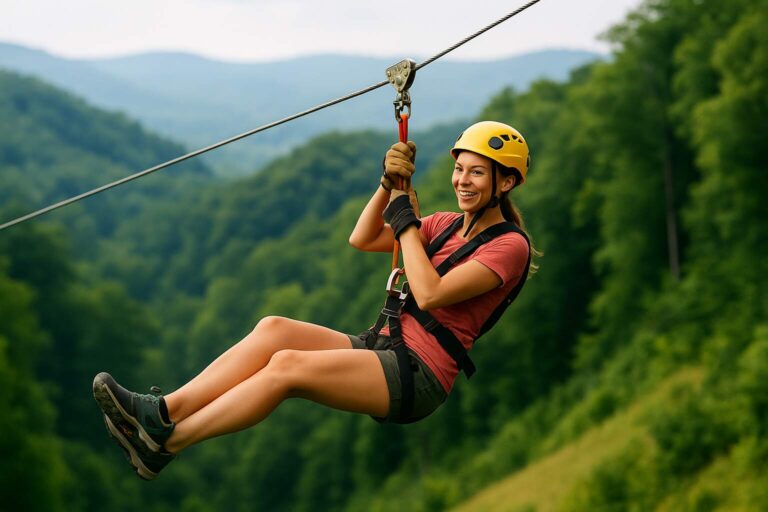The world of adventure sports is full of thrilling activities, from bungee jumping to skydiving, but where does ziplining fit in? Ziplining has become increasingly popular in recent years, with millions of people around the world enjoying the rush of sliding down a wire high above the ground. But is ziplining truly an extreme sport?
The answer to this question is subjective and depends on how we define extreme sports. Ziplining can provide a thrilling and exciting experience, but it may not meet all of the characteristics that define extreme sports. While ziplining can reach high speeds and heights, it is not as physically demanding, competitive, or risky as many other activities classified as extreme sports.
In this article, I’ll explore the characteristics of extreme sports and compare them to the experience of zip lining. By the end, I’ll have a better understanding of whether ziplining can truly be considered an extreme sport or not.
Ziplining as an Adventure Activity
Ziplining, also known as zip-lining or zip wires, is an adventure activity that involves sliding down a suspended cable while wearing a harness and other safety equipment. Zipline courses can be found in various locations around the world, including forests, canyons, and even urban areas.
Ziplining courses can range in length from a few hundred feet to several thousand feet and can reach speeds of up to 100 miles per hour. While ziplining, participants can enjoy stunning views of their surroundings, and often, zipline courses are designed to take participants through scenic areas.
Compared to other adventure activities, such as rock climbing or white water rafting, ziplining is considered to be relatively safe. However, participants are still required to follow strict safety guidelines, such as wearing helmets and harnesses and following instructions from trained professionals.
Overall, ziplining offers a unique and exciting way to experience the outdoors and is suitable for people of all ages and fitness levels.
Characteristics of Extreme Sports
To determine whether ziplining is an extreme sport, we need to first examine the characteristics that define extreme sports. These are:
- High Speeds: Extreme sports typically involve high speeds that can exceed those of traditional sports.
- Height: Activities that involve extreme heights, such as base jumping or cliff diving, are often considered extreme sports.
- Physical Demands: Extreme sports often require participants to have a high level of physical fitness and skill.
- Thrill and Adrenaline: Extreme sports are characterized by the rush of adrenaline that comes with taking part in the activity.
- Risk: Extreme sports are inherently risky and can result in injury or death if proper safety precautions are not taken.
- Competition: Many extreme sports are competitive and involve competing against other individuals or teams.
Arguments for Ziplining as an Extreme Sport
While ziplining may not meet all of the characteristics that define extreme sports, there are several arguments for why ziplining can be considered an extreme sport:
- Speed and Height: Ziplining can reach high speeds and heights, especially on longer and steeper courses. This can provide a thrill and sense of excitement similar to other extreme sports.
- Physical Demands: While ziplining may not require as much physical fitness and skill as other extreme sports, it still requires participants to have a certain level of strength and coordination to navigate the course safely.
- Thrill and Adrenaline: Ziplining can provide a unique and thrilling experience that can produce an adrenaline rush for participants.
- Comparison with other activities classified as extreme sports: Ziplining may not be as extreme as activities such as base jumping or extreme skiing, but it shares similarities with activities like zip-lining, high-wire walking, and even some forms of bungee jumping.
Overall, while ziplining may not meet all of the characteristics that define extreme sports, it can provide a thrilling and exhilarating experience that is similar to other activities that are considered extreme sports.
Arguments Against Ziplining as an Extreme Sport
While there are arguments for considering ziplining an extreme sport, there are also several arguments against this classification:
- Safety Measures: Ziplining is a relatively safe activity when compared to other extreme sports. While there is always some level of risk involved, the safety measures and equipment used in ziplining courses are designed to minimize these risks.
- Lack of Competition: Unlike many other extreme sports, ziplining is not a competitive activity. Participants are typically not competing against others but rather enjoying the experience and the scenery.
- Lack of Specialized Equipment: Ziplining requires specialized equipment such as harnesses, helmets, and cables, but these are not unique to ziplining and are also used in other adventure activities.
- Comparison with other activities not classified as extreme sports: While ziplining may be a thrilling and exciting experience, it does not involve the same level of physical demands, risk, or competition as activities such as rock climbing, whitewater rafting, or extreme skiing.
Overall, while ziplining can provide a unique and exciting experience, it may not meet all of the characteristics that define extreme sports. While it can be thrilling and exciting, it does not involve the same level of physical demands, risk, or competition as other activities classified as extreme sports.
If you planning to go on a zipline adventure I recommend you to read the essential zipline dos and don’ts to be fully prepared.
Conclusion
In conclusion, the question of whether ziplining is an extreme sport is a subjective one that depends on how we define extreme sports. While ziplining may not meet all of the characteristics that define extreme sports, it can provide a thrilling and exhilarating experience that is similar to other activities that are considered extreme sports.
On the other hand, arguments against considering ziplining an extreme sports focus on the fact that it is a relatively safe activity, lacks competition, and does not involve the same level of physical demands, risk, or specialized equipment as other extreme sports.
In the end, whether ziplining is considered an extreme sport or not, what matters most is that participants are aware of the potential risks involved, follow all safety guidelines, and enjoy the experience in a responsible and safe manner.








